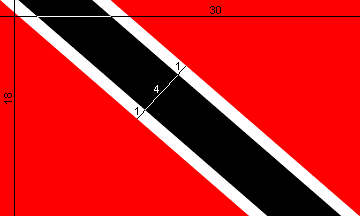![[Flag of Trinidad and Tobago]](../images/t/tt.gif) image by Željko Heimer, 6 April 2003
image by Željko Heimer, 6 April 2003
Last modified: 2023-09-09 by rob raeside
Keywords: trinidad | tobago | caribbean | america | trinidad and tobago |
Links: FOTW homepage |
search |
disclaimer and copyright |
write us |
mirrors
![[Flag of Trinidad and Tobago]](../images/t/tt.gif) image by Željko Heimer, 6 April 2003
image by Željko Heimer, 6 April 2003
Official Name: Republic of Trinidad and
Tobago
Flag adopted: 1962
See also:
The red is said to represent the vitality of the land and
people, the warmth and energy of the sun, and courage and
friendliness. The white is said to represent the sea, the purity
of national aspirations, and the equality of all men, and the
black represents strength, unity and purpose, and the natural
resources. (from [smi75b]).
Red stands for 'people's generosity and sunlight', white for
'equality and sea' and black for 'tenacity and vocation for
unity'. (from a 1994 translation of [taL82]).
From <www.gov.tt>:
"The national flag was designed by the Independence
Committee and selected to be used as the National Flag in 1962.
Its colours are Red, White and Black. Red is the colour most
expressive of our country, it represents the vitality of the land
and its people, it is the warmth and energy of the sun, the
courage and friendliness of the people. White is the sea by which
these lands are bound; the cradle of our heritage; the purity of
our aspirations and the equality of all men under the sun. The
Black represents for us the dedication of the people joined
together by one strong bond. It is the colour of strength, of
unity, of purpose and of the wealth of the land. The colours
chosen represent the elements Earth, Water and Fire which
encompass all our past, present and future and inspire us as one
united, vital, free and dedicated people."
Erki Kurikoff, 13 February 2002
Articles IV(4), V and VI all say that the National Flag should
be raised in the morning a lowered at night (the actual times
vary). But all Articles refer to official rather than private
display.
Christopher Southworth, 4 April 2003
From 'The National Flag of the Republic of Trinidad and
Tobago', undated but must be from after 1976 (when Trinidad
became a republic), and the specifications it contains are
identical to those issued by 'The Ministry of Home Affairs' on 31
August 1962:
'Chapter I - The official description of the Flag reads as
follows: "On a red field, a Bend Dexter Sable bordered
Silver; that is to say, there is on the Red Field a diagonal from
left to right in Black bordered with White. The width of
the Black and White bands joined side by side at the upper dexter
corner of the Flag is one-fifth of the full length of the Flag,
and the width of each White band is one-sixth of the width of the
Black and White bands together. The width of Black is
therefore four-sixths of the total width of the White and
Black". The Black and White diagonals must always point to
the peak of the staff. "The dimensions of the National Flag
shall be in the proportions of five to three (5:3). For
flags carried at sea the dimensions shall be two to one
(2:1)"'
Christopher Southworth, 29 March 2003
According to Album 2000 [pay00]
- National Flag on land (-SW/--- 3:5) - Red flag with a black
falling diagonal fimbriated white. Both Album 2000 and [smi83] mark usage as (-SW/---);
does it mean that there are some prohibitions regarding the use
of this flag by private citizens on land?
Željko Heimer, 6 April 2003
The regulations say only this:
"ARTICLE III - SPECIAL DAYS FOR FLYING THE NATIONAL FLAG -
The dates of special significance for this country on which the
National Flag may be flown freely by all citizens are as
follows:
- 1. Independence Day - 31 August.
- 2. Republic Day - 24 September.
- 3. Remembrance Day - 2nd Sunday in November.
- 4. Any other date that may be prescribed from time to time.
The above gives the dates upon which the National Flag may be
flown freely by all citizens, but there seems to be nothing in
the remaining 24 Articles to explain what happens on other
days? The mystery remains.
Christopher Southworth, 6 April 2003
 image by Željko Heimer, 6 April 2003
image by Željko Heimer, 6 April 2003
The regulations require that the width of the white and black
stripes together is 1/5 of the length, with white and black
stripes being 1-4-1. It is nowhere specifically explained, but
the diagonal stripe is set so that it makes edges only along the
top and bottom and not along hoist and fly, that it touches with
one point only.
Željko Heimer, 6 April 2003
The protocol manual for the
London 2012 Olympics
(Flags and Anthems Manual
London 2012 [loc12]) provides recommendations
for national flag designs. Each
NOC
was sent an image of the flag, including the
PMS shades, for their approval by LOCOG. Once this was obtained, LOCOG produced
a 60 x 90 cm version of the flag for further approval. So, while these specs may
not be the official, government, version of each flag, they are certainly what
the NOC
believed the flag to be.
For Trinidad and Tobago: PMS 186 red and black. The vertical flag is simply the
horizontal version turned 90 degrees clockwise.
Ian Sumner, 10 October 2012